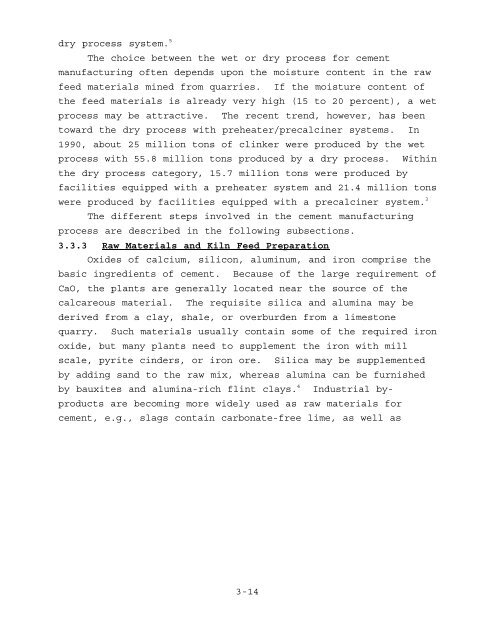NOx Emissions from Cement Mfg - US Environmental Protection ...
NOx Emissions from Cement Mfg - US Environmental Protection ...
NOx Emissions from Cement Mfg - US Environmental Protection ...
You also want an ePaper? Increase the reach of your titles
YUMPU automatically turns print PDFs into web optimized ePapers that Google loves.
dry process system. 5<br />
The choice between the wet or dry process for cement<br />
manufacturing often depends upon the moisture content in the raw<br />
feed materials mined <strong>from</strong> quarries. If the moisture content of<br />
the feed materials is already very high (15 to 20 percent), a wet<br />
process may be attractive. The recent trend, however, has been<br />
toward the dry process with preheater/precalciner systems. In<br />
1990, about 25 million tons of clinker were produced by the wet<br />
process with 55.8 million tons produced by a dry process. Within<br />
the dry process category, 15.7 million tons were produced by<br />
facilities equipped with a preheater system and 21.4 million tons<br />
were produced by facilities equipped with a precalciner system.<br />
3<br />
The different steps involved in the cement manufacturing<br />
process are described in the following subsections.<br />
3.3.3 Raw Materials and Kiln Feed Preparation<br />
Oxides of calcium, silicon, aluminum, and iron comprise the<br />
basic ingredients of cement. Because of the large requirement of<br />
CaO, the plants are generally located near the source of the<br />
calcareous material. The requisite silica and alumina may be<br />
derived <strong>from</strong> a clay, shale, or overburden <strong>from</strong> a limestone<br />
quarry. Such materials usually contain some of the required iron<br />
oxide, but many plants need to supplement the iron with mill<br />
scale, pyrite cinders, or iron ore. Silica may be supplemented<br />
by adding sand to the raw mix, whereas alumina can be furnished<br />
4<br />
by bauxites and alumina-rich flint clays. Industrial by-<br />
products are becoming more widely used as raw materials for<br />
cement, e.g., slags contain carbonate-free lime, as well as<br />
3-14

















